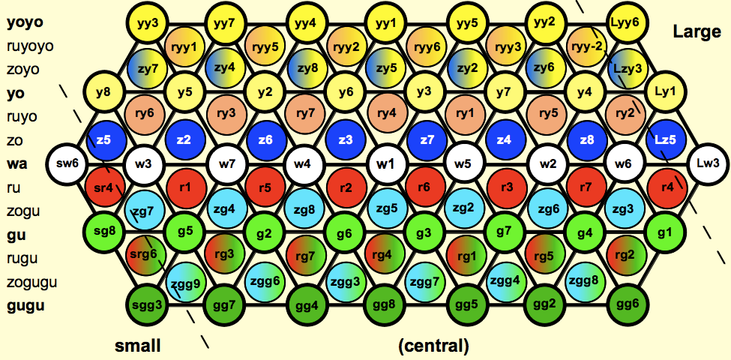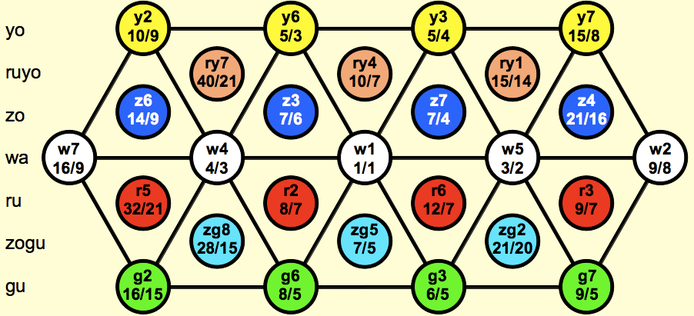Kite's color notation
Kite's color notation
The following is excerpted from Kite's book, "Alternative Tunings: Theory, Notation and Practice", available at www.TallKite.com.
Color notation provides a way to talk about ratios without using numbers, making microtonal music more accessible to people who aren't mathematically inclined. It's designed for just intonation, but like sagittal notation, it can be expanded to cover temperaments. Also, even those who never use JI still generally talk about ratios quite a bit, and this notation can be a useful tool. For example, temperaments can be named after the color of the comma(s) that are tempered out.
CRASH COURSE:
Wa = white (strong but colorless) = 3-limit
Yo = yellow (warm and sunny) = 5-over = major
Gu ("goo") = green (not as bright as yellow) = 5-under = minor
Zo = blue/azure (dark and bluesy) = 7-over = subminor
Ru = red (alarming, inflamed) = 7-under = supermajor
A color and a degree indicates a ratio, and vice versa. 3/2 = wa 5th = w5. The colors come in a red-yellow-green-blue rainbow, with warm/cool colors indicating sharp/flat intervals. The rainbow of 3rds: r3 - y3 - g3 - z3 = 9/7 - 5/4 - 6/5 - 7/6. Azure is used instead of blue because b looks like a flat sign. Mnemonic: Z looks like 7 with an extra line on the bottom.
25/16 = yoyo 5th = yy5. Notes are named wC, zE♭, yyG#, etc.
Ya means 5-all and includes wa, yo, gu, yoyo, gugu, etc. Ya = the 2.3.5 subgroup = 5-limit. Za = 7-all = 2.3.7. Yaza = 2.3.5.7 = 7-limit.
Triads are named after their 3rd: Cy, Gz, etc. The four main yaza triads:
Tetrads are named Cy6, Dg7, etc. The 11 main yaza tetrads, with homonyms equated:
The y,z7 chord is also called the h7 chord ("aitch-seven"), because it's part of the harmonic series. The s7 ("sub-seven") chord is part of the subharmonic series. It's the first 7 subharmonics, with the 3rd subharmonic becoming the root. Note that it has no 7th. There are h9 chords, s11 chords, etc.
Chord progressions: The tonic is always wa. The root of each chord has a color, which defaults to wa. C - Am - F - G would be Cy - yAg - Fy - Gy.
In relative notation, the I, IV and V chords are assumed to have wa roots unless otherwise specified, so this becomes Iy -- yVIg -- IVy -- Vy.
Staff notation: Here's Ih7 -- IVh7 -- Ih7 -- Vh7 in B flat:
More remote intervals are large (fifthward) and small (fourthward). Central means neither large nor small. The magnitude is found by adding up all the monzo exponents but the first, dividing by 7, and rounding off. 0 = central, 1 = large, 2 = double large, etc.
Temperaments are named after the color of the comma(s) they temper out. 5-limit Porcupine = triple yo = y3T. 7-limit porcupine = triple yo and ru = y3&rT. The name indicates the prime subgroup and the rank of the temperament.
Colors for primes > 7 are named after the number itself:
Lova = 11-over, lu = 11-under, la = 11-all. (Lova not lo, because "lo C" sounds like "low C".) Lova and lu are abbreviated to 1o and 1u in interval names and chord names, e.g. lova 4th = 1o4 = 11/8 and C lova-7 = C1o7 = 1/1 - 11/9 - 3/2 - 11/6. The associated color is lavender (mnemonic: "e-leven-der"), which refers to both lova and lu, since they are only 7.1¢ apart (e.g. lo 3rd = 11/9 and lu 3rd = 27/22). More precisely, lova notes are lovender, and lu notes are luvender.
Tho = 13-over, thu = 13-under, tha = 13-all. Tho and thu are abbreviated to 3o and 3u in interval names and chord names, e.g. 13/8 = 3o6 = tho 6th.
Yala = 2.3.5.11, yazalatha = 2.3.5.7.11.13 = 13-limit, and yalatha nowa = 2.5.11.13.
So = 17-over, su = 17-under, sa = 17-all, abbreviated as 17o and 17u. Sova is an alternate form of so, to distinguish it from the solfege syllable Sol.
Nova = 19-over, nunda = 19-under, na = 19-all, abbreviated as 19o and 19u. Nova because "no 3rd" could mean either 19/16 or thirdless. Nunda because "the nu key" sounds like "the new key".
Twenty-tho = 23-over, twenty-thu = 23-under, twenty-tha =23-all, abbreviated as 23o and 23u.
Twenty-no/-nu/-na = 29, thirty-wo/-wu/-wa = 31, thirty-so/-su/-sa = 37, etc.
The alternate forms with -ova or -unda are only needed when the color word appears alone. Thus 11/7 = loru 5th, not lovaru 5th.

